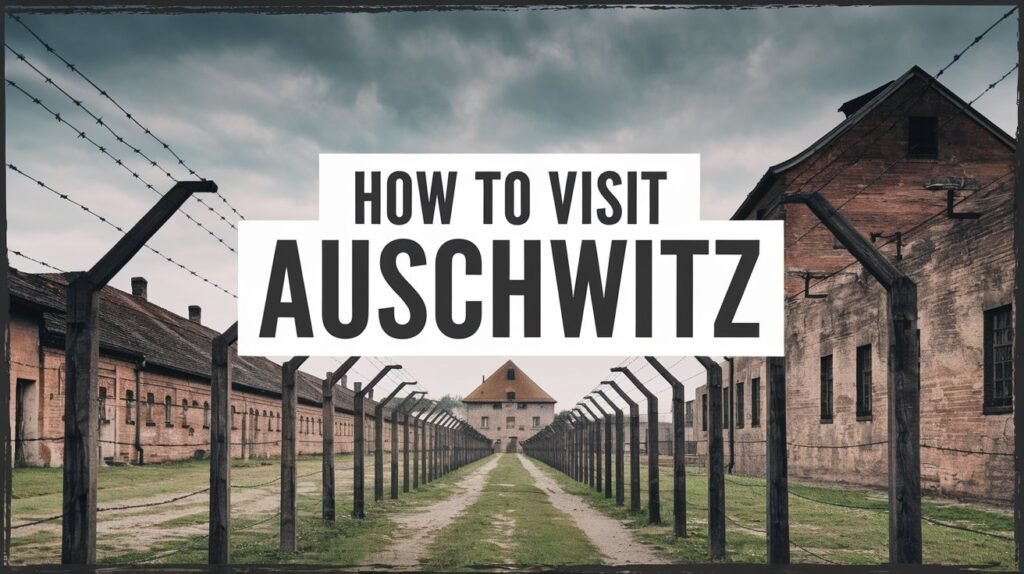Visiting Auschwitz-Birkenau can deeply change how you view history. Join us on an unforgettable journey into history’s dark times with the Auschwitz-Birkenau History Tour. This detailed tour gives deep insights into the evils of WWII, taking you through the grim places of Auschwitz I and Auschwitz II-Birkenau.
This post may contain affiliate links. If you make a purchase or booking through one of our links, we may earn a small commission. As an Amazon Associate, I earn from qualifying purchases. The content on this website was created with the help of AI.
See the remains of the barracks, gas chambers, and crematoria. These tell the sad tales of those who suffered. Expert guides lead you, turning these tours into moving experiences of remembering and learning. Hearing personal stories and seeing artifacts during your guided tour brings an even deeper understanding of this significant journey.

Key Takeaways
- Delve into the historical significance of Auschwitz-Birkenau.
- Learn the compelling stories behind the somber sites.
- Understand the importance of the barracks, gas chambers, and crematoria.
- Gain insights from experienced, English-speaking guides.
- Experience a thoughtful remembrance through Auschwitz-Birkenau guided tours.
Introduction to Auschwitz-Birkenau
The importance of Auschwitz-Birkenau is immense. It’s about 40 miles from Kraków, Poland. This place deeply affects those who visit it. It includes Auschwitz I, Auschwitz II-Birkenau, and Auschwitz III-Monowitz. These camps were central to a huge tragedy in history. Over 1.3 million were sent here, and about 1.1 million lost their lives.
The Historical Significance
Auschwitz-Birkenau, set up in 1940, is a stark reminder of the Holocaust’s terror. It was key to the Nazis’ plan to target 11 million European Jews. The camps hold the sorrowful stories of 1.095 million Jews, along with many others. This mix includes 140,000 to 150,000 non-Jewish Poles, 23,000 Roma, 15,000 Soviet prisoners of war, and 25,000 from different backgrounds. The three camps together are a chilling symbol of human brutality.
Why Visit Auschwitz-Birkenau?
Visiting the Auschwitz-Birkenau memorial is more than a history lesson. It’s about showing respect and learning about a tragic time. You see the places where unimaginable suffering happened. This visit teaches the vital importance of tolerance and shows what can happen from hate. It’s a key experience for understanding these historical events. Memorial visits help keep the victims’ memories alive.
Here are some numbers on the catastrophe at Auschwitz-Birkenau:
| Category | Number Deported | Number of Deaths |
|---|---|---|
| Jews | 1,095,000 | 960,000 |
| Non-Jewish Poles | 140,000 – 150,000 | 74,000 |
| Roma | 23,000 | 21,000 |
| Soviet POWs | 15,000 | 15,000 |
| Other Nationalities | 25,000 | 10,000 – 15,000 |
Auschwitz I: The Main Camp
The journey through Auschwitz-Birkenau begins at Auschwitz I, the main camp. Here, original buildings and barracks serve as quiet witnesses to past horrors. This part of the camp gives a crucial view into the terrible reality that prisoners faced daily.
Original Buildings and Barracks
When you visit Auschwitz I main camp, you’ll see the structures where many were held in brutal conditions. The surviving barracks show the extent of suffering under the Nazis. About 1.3 million people were sent here from 1940 to 1945, mostly Jews, among others.
The ‘Arbeit Macht Frei’ Gate
The ‘Arbeit Macht Frei’ gate at Auschwitz I main camp is a symbol of great deceit. It falsely declares “Work Sets You Free,” hiding the truth of enslavement and death. The gate serves as a stark reminder of the cruelty faced by over a million souls, including 960,000 Jews.
Beginning to truly understand the Holocaust starts with an Auschwitz-Birkenau exploration. Visiting these sites helps us deeply appreciate the strength and bravery of those who died and those who survived.
Auschwitz II-Birkenau: Expansion and Extermination
Auschwitz II-Birkenau shows the vast extent of the Nazis’ plan to kill many people. This part of the camp shows us the dark chapter of mass killing clearly. It highlights the terrible truth of planned extermination.
Gas Chambers and Crematoria
The famous gas chambers at Auschwitz and crematoria symbolize the Holocaust’s massive scale. The ruins of these terrible places show how efficiently the camp worked to kill people. The crematoria were used for killing en masse and then getting rid of many innocent people. As key Auschwitz-Birkenau landmarks, they make us think about the cruel treatment of the victims.
The Personal Artifacts
At Auschwitz II-Birkenau, you can see personal items that give a touching view of changed lives. Things like shoes, suitcases, and photos tell personal stories beyond the large numbers. These items remind us of the many lives lost. This part of the camp shows the deep human loss of the Holocaust. It tells us about the personal pain and lasting sadness in every item left behind.
| Aspect | Details |
|---|---|
| Annual Visitors | Over 500,000 |
| International Representation | Auschwitz featured in global Holocaust museums |
| Artifacts Displayed | Personal belongings like shoes and suitcases |
| Comparative Exhibitions | Yad Vashem |
| Primary Functions | Educational, Memorial |
The Role of Guided Tours
Taking a guided tour at Auschwitz-Birkenau is a deeply moving experience. It’s not just about seeing the site. It allows visitors to hear powerful stories and understand the site’s real significance.
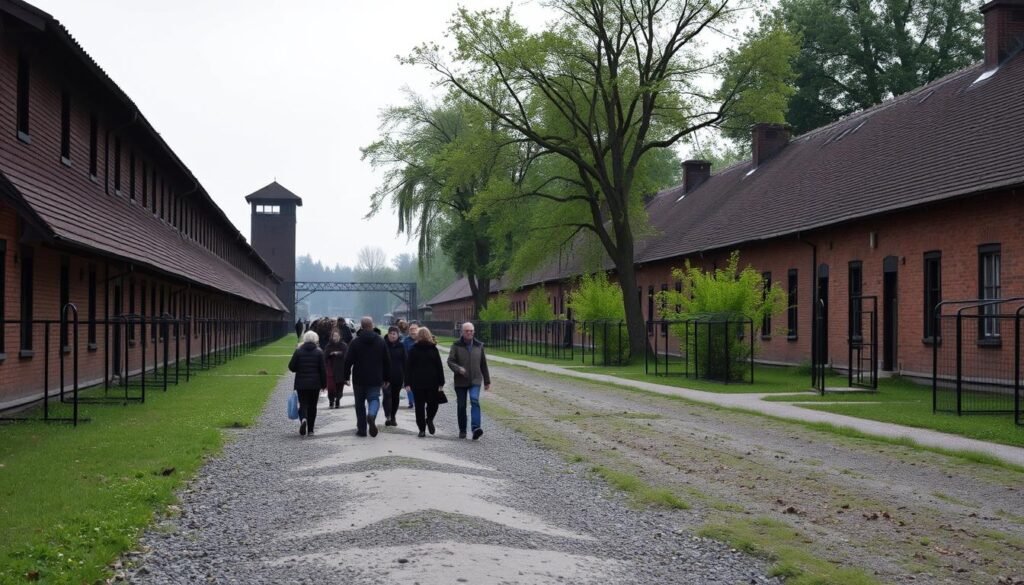
Benefits of an English-Speaking Guide
An English-speaking guide adds immense value to the Auschwitz-Birkenau tours. They explain the complex history with care, helping visitors grasp what happened here. This ensures visitors leave with a deep understanding of the site’s historical importance.
Touring with Small Groups
Touring Auschwitz-Birkenau in small groups makes the experience more personal and immersive. It allows people to closely connect with the history. Everyone can interact with the guide, ask questions, and ponder the significance of what they see. This deepens the visit’s impact.
| Aspect | Guided Tour |
|---|---|
| Duration of Auschwitz I | Approx. 2 hours |
| Duration of Auschwitz II – Birkenau | Approx. 1 hour |
| Group Size | Small groups for a personal experience |
| Languages Available | Multiple, including English |
| Shuttle Buses | Free, every 10 minutes |
Traveling from Warsaw to Auschwitz-Birkenau
Starting your trip to Auschwitz-Birkenau means planning carefully. You can take a beautiful train ride or drive in private. Knowing your options makes the trip smooth and memorable.
Options: Train or Car
You can travel from Warsaw to Auschwitz-Birkenau by train or car. Let’s compare these options:
| Mode of Transport | Details | Total Time | Cost (PLN) |
|---|---|---|---|
| Train | Train from Warsaw to Krakow (2.5 hours) + Bus to Auschwitz (1.5 hours) | 16 hours (including guided tour) | 650-750 per person |
| Car | Direct drive from Warsaw to Auschwitz (4.5 hours) | Approximately 14 hours | 490-1500 per person |
Your choice might depend on your budget, time, and what you like. Trains are relaxing. Cars offer freedom and speed.
Pick-Up and Drop-Off Services
For a better trip to Auschwitz-Birkenau, there are services for pick-up and drop-off. They include:
- Hotel Transfers
- Station Pickups
- Direct Drop-Off at Auschwitz
These services make your trip worry-free. You can then reflect on your visit’s deeper meaning. Below are the costs for various tours:
| Participants | Tour Without Pickup (PLN) | Tour With Pickup (PLN) | Private Car Tour (PLN) |
|---|---|---|---|
| 1 | 650 | 750 | 1500 |
| 2 | 550 | 620 | 800 |
| 3 | 490 | 560 | 590 |
| 4 | 470 | 530 | 540 |
| 5 | 450 | 520 | 510 |
| 6 | 440 | 510 | 490 |
| 7 | 425 | 505 | Contact for pricing |
| 8 or more | 390 | 490 | Contact for pricing |
Choosing wisely can make your journey to Auschwitz-Birkenau organized and respectful. It turns history into an experience.
What to Expect During Your Visit
Planning a trip to Auschwitz-Birkenau is a deeply moving journey. Knowing what to expect can enhance your visit. You’ll get the most from this solemn experience.
Duration and Itinerary
The tour of Auschwitz-Birkenau usually lasts a full day. It begins at Auschwitz I, taking about two hours to see the historic buildings and the ‘Arbeit Macht Frei’ gate. Then, the tour moves to Auschwitz II – Birkenau, 3 kilometers away. A free shuttle bus runs every ten minutes for easy travel between the sites.
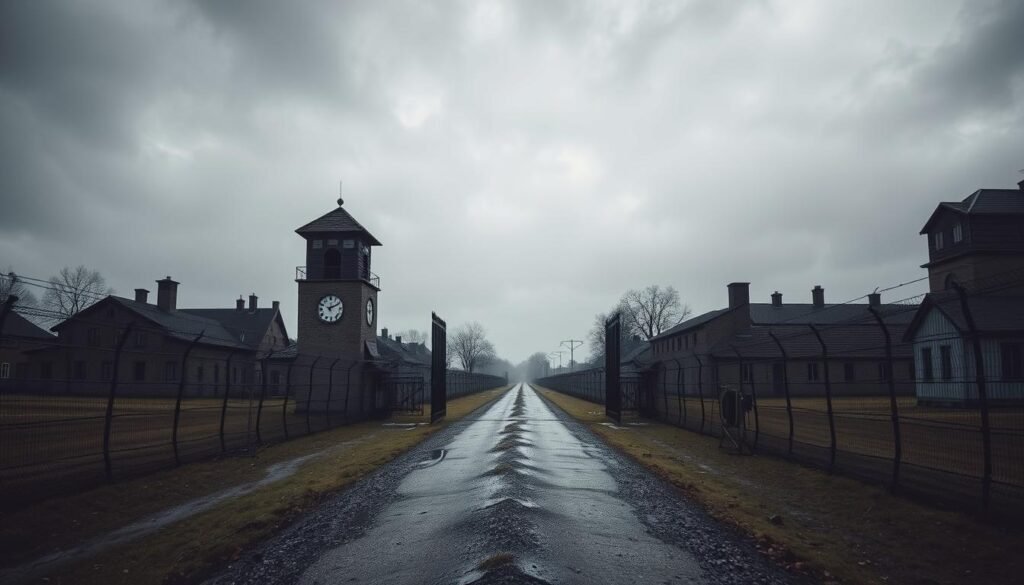
The complete guided tour takes around three hours. You’ll see barracks, gas chambers, and important structures, remembering the tragic history. This plan ensures you see much in a short time, providing learning and time to reflect.
Respectful Conduct and Memorial Significance
Visiting Auschwitz with respect is essential. It’s important to act with solemnity and reverence, remembering the site’s tragic past. The memorial reminds us of the suffering of millions, especially the Jewish community, whose numbers were greatly reduced during WWII.
Everyone should act thoughtfully, honoring the memory of the lives lost. With the right mindset, we can help maintain the respect this historical place deserves.
Key Landmarks to Explore
Exploring Auschwitz-Birkenau means looking at its vast, haunting area. The place shows the huge wrongs of World War II. When you walk this area, about 8 miles long, you see important landmarks. They give a hard but needed look into the past.
The Camp Layout
The layout of the camp is key to understanding its history. Auschwitz I and Auschwitz II-Birkenau had different roles. The main camp, Auschwitz I, had the first barracks and offices. Auschwitz II-Birkenau was bigger and was where most of the killings happened.
Start your tour at the ‘Arbeit Macht Frei’ gate. This gate’s saying, “Work Sets You Free,” is a cruel irony. Next, you’ll see the ramp where prisoners arrived, unsure of the horror ahead. This ramp is a crucial place, where many families were split forever.
Significant Structures
Several structures within Auschwitz-Birkenau have deep historical and emotional impact:
| Structure | Description |
|---|---|
| Barracks | These held prisoners in tight, dirty conditions. Seeing them shows the hard daily life there. |
| Gas Chambers | These were death sites of many, a stark look at the camp’s dark role. |
| Crematoria | Used to get rid of the victims’ bodies, these show the tragedy’s huge scale. |
| Undressing Rooms | Meant to trick victims, these rooms led straight to the death chambers. |
| Watchtowers | These towers, all over the camp, showed the constant watch over prisoners. |
These important places at Auschwitz tell parts of a sad story. They show the strong spirit of those who still hoped, despite the horrors. Walking here, you feel the past’s heavy weight. It reminds us to never let such tragedies happen again.
Educational Aspects of the Tour
An Auschwitz-Birkenau educational experience offers a deep look into the Holocaust. This tour is carefully crafted to teach about the Holocaust in a way that feels real and important. Through stories and artifacts, the harsh truths of history come alive.
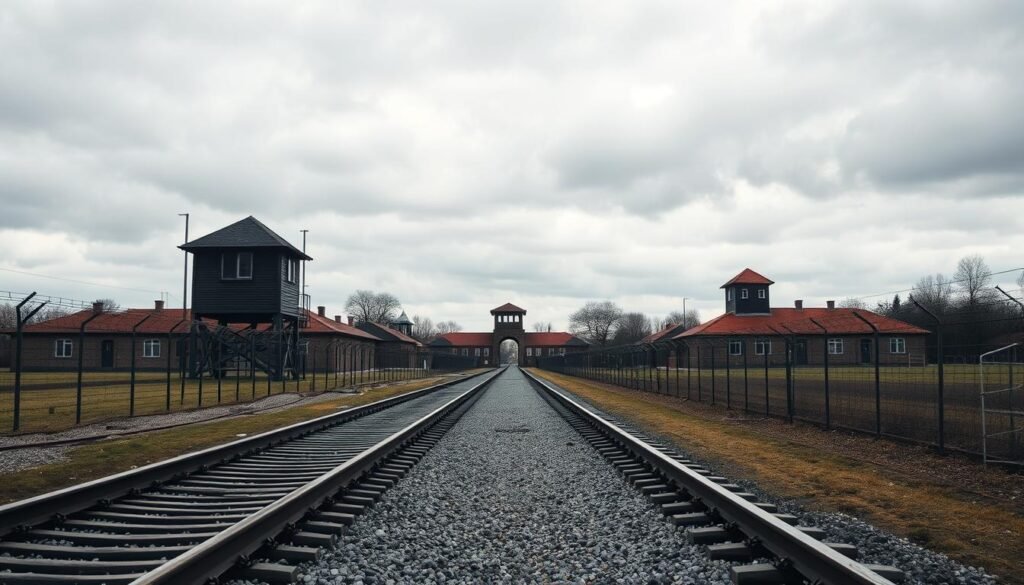
Understanding the Holocaust
The tour gives an in-depth view of Holocaust history, showing the horror of what happened. It starts with a pre-trip study that includes three parts. These cover Holocaust history and medical history during that time. This study prepares visitors for their visit to Auschwitz I and II over seven days, blending learning and real-life exploration.
Personal Stories and Artifacts
The tour is powerful because it shares personal stories and objects. These items remind us of the lives lost and the pain endured. Visitors also take part in writing and talks that help them think and feel deeply about what they’ve learned. This method highlights courage, social awareness, and how harmful dehumanization is. It urges visitors to think deeply about bioethics and the Holocaust.
| Aspect | Details |
|---|---|
| Pre-Trip Curriculum | Three modules including general history and the history of medicine during the Holocaust |
| Program Duration | Approximately 9 weeks (2 weeks trip + 7 weeks seminar) |
| Participation | 100% student participation in post-trip interviews |
| Main Themes | Bioethics, moral courage, social awareness, dehumanization |
| Funding | Entirely donor-funded |
This journey through the Auschwitz-Birkenau educational experience teaches vital lessons on human rights. It ensures we feel the weight of history, not just learn facts. This makes it a key part of learning about the Holocaust.
Memorials and Monuments
Exploring Auschwitz-Birkenau, you will find it a deeply moving journey. The visit to the memorials and monuments is a highlight. They honor and protect the memory of those lost during the Holocaust.
The Impactful Memorial Sites
The memorials at Auschwitz-Birkenau are located to deeply affect visitors. Each memorial tells a story of great loss and suffering. As you explore, you are invited to think about the past and the importance of Remembering Holocaust victims.
- The International Monument: Constructed to emphasize the global impact of the Holocaust.
- Women’s Camp Memorial: Dedicated to the suffering and resilience of female prisoners.
- The Monument to the Victims of Fascism: A reminder of the terrible results of fascist beliefs.
Remembering the Victims
The memorials and monuments serve as lasting reminders. They ensure we never forget the horrible events. They teach and memorialize, driving home the message “Never Again.” You are encouraged to pay your respects and commit to Remembering Holocaust victims.
On your tour, you will also see:
| Memorial | Description |
|---|---|
| The International Monument | It highlights the importance of global remembrance. |
| Children’s Memorial | This memorial pays tribute to the youngest victims, with symbols of lost innocence. |
Practical Tips for Your Visit
Visiting Auschwitz-Birkenau is deeply moving. It demands careful planning. To make your visit respectful and informed, follow these tips:
Booking Your Tour
Booking Auschwitz tour early is crucial. Tours fill up fast, especially in peak seasons. A guided tour is about 85 złoty (18 euros) per person. Students get a discount and only pay 75 złoty. Last-minute plans often fail, so planning ahead is wise.
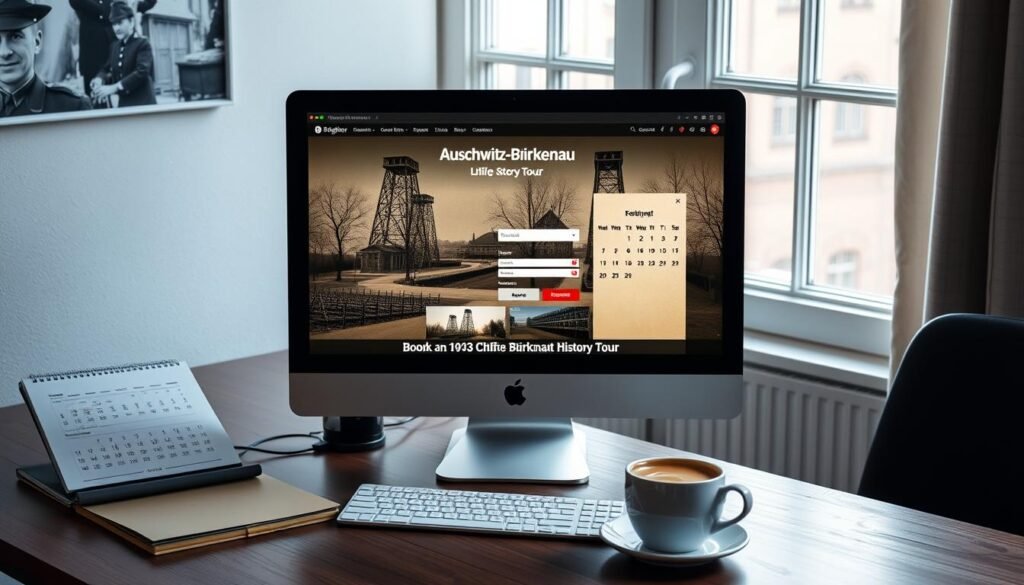
What to Bring and What to Leave Behind
Be well-prepared for your visit. Wear comfy shoes since you’ll walk a lot; it’s a 3 km distance between Auschwitz I and II. The walk takes 30 to 40 minutes. Dress for the weather and carry only a small bag. Large bags and food are not allowed.
- Bring:
- Comfortable shoes
- Weather-appropriate clothing
- Small bag for essentials
- Leave Behind:
- Large bags
- Food items
- Bulky personal belongings
Follow these Auschwitz visit tips for a respectful experience. Knowing what to bring and leave is key for the visit’s dignity.
Auschwitz-Birkenau History Tour Highlights
The Auschwitz-Birkenau tour highlights take you through a profound journey of history. It offers a deep understanding of a very dark chapter in human history. As you pass the infamous gates of Auschwitz I, you think of the millions affected by these tragic events. The words “Arbeit Macht Frei” over the gate remind us of the cruelty faced by those who entered.
Exploring Auschwitz II-Birkenau, the vastness of the site is overwhelming. The size of the extermination places, like the gas chambers and crematoria, shows the scale of horrors faced by the victims. Walking through, you’re reminded of the over 1 million lives lost, mainly Jews from Europe. Shoes, suitcases, and photos on display tell individual stories within the broader history.
The tour becomes more emotional when learning the facts. Hearing personal stories and seeing artifacts gives a sobering insight into the cruel reality millions faced. With an English-speaking guide, these stories hit even harder, helping visitors understand the importance of what they are seeing.
| Camp | Historical Significance | Estimated Deaths | Victim Demographics |
|---|---|---|---|
| Auschwitz-Birkenau | Largest extermination camp | 1 million+ | Jews from across Europe |
| Majdanek | Multipurpose camp | 80,000 | Individuals from 28 countries |
| Treblinka | Extermination camp | 1,000 people per hour at peak | Polish Jews |
| Belzec | Extermination camp | 430,000 – 500,000 in six months | Jews from surrounding regions |
| Krakow | Historical Jewish population | Approx. 70,000 pre-WWII | Local Jewish community |
From the rebuilt barracks of Auschwitz I to the haunting vastness of Auschwitz II-Birkenau, the tour covers nearly 8 miles of walking. It provides a detailed look at the site. This tour is a journey not just through a place, but through a very important historical story—one we must always remember. Visiting these spots offers a sobering, educational, and crucial experience, highlighting the lasting impact of the Holocaust.
Conclusion
Reflecting on the Auschwitz tour, you gain more than historical facts. It teaches deep respect for the 1 million mostly Jewish lives lost. Visiting the room of hair and viewing prisoner shoes offers somber reminders that touch the heart.
The tour, lasting about 3 hours, educates and reminds us of the power of resilience against hate. Seeing the “Arbeit Macht Frei” sign and exploring gas chambers at Auschwitz II-Birkenau brings insights into the victims’ suffering.
We encourage you to remember these lessons and share them with others. By visiting respectfully and reflecting thoughtfully, you help keep the memory of the victims alive. A visit to Auschwitz deeply connects you to history, motivates fighting against hate, and raises awareness for all visitors.
FAQ
What are the highlights of the Auschwitz-Birkenau History Tour?
The tour shows the original Auschwitz I structures and the ‘Arbeit Macht Frei’ gate. You’ll see the large area and remains of Auschwitz II-Birkenau. Areas like the gas chambers, crematoria, and personal items bring history to life.
Why visit Auschwitz-Birkenau?
Visiting teaches about the Holocaust’s horrors. It’s a chance to honor the victims. You’ll learn the importance of tolerance and the dangers of hatred.
What can I expect to see at Auschwitz I?
You’ll see the original buildings and the ‘Arbeit Macht Frei’ gate. Inside, you’re shown how prisoners lived and suffered. This shows the Nazi’s cruel ways.
What is significant about Auschwitz II-Birkenau?
Auschwitz II-Birkenau shows the horror’s scale with its huge area and remains. The personal items share victims’ stories. This highlights both the vast numbers and individual suffering.
Are guided tours available at Auschwitz-Birkenau?
Yes, guided tours are offered. Guides share deep history, making the visit more meaningful. Tours are available in English for those who don’t speak Polish.
How can I travel from Warsaw to Auschwitz-Birkenau?
You can take a scenic train ride or a private car from Warsaw. Tours make it easy with pick-up and drop-off. This lets you focus on the visit’s meaning.
What should I expect during my visit?
The visit is deep and emotional, taking a full day. The tour includes both camps, focusing on respectful behavior. It’s a time to remember and honor those lost.
What are some key landmarks to explore at Auschwitz-Birkenau?
Important sites are the unloading ramps, prisoner barracks, and gas chamber remains. Each helps understand the tragedy and the strength of the prisoners. These places help tell the camp’s dark story.
What educational aspects does the tour offer?
The tour gives detailed accounts of the Holocaust’s horrors through stories and artifacts. Adding personal stories makes the historical facts moving learning moments.
Are there memorials and monuments at Auschwitz-Birkenau?
Yes, there are memorials for victims from various countries. These memorials remind us of the great loss. They encourage respect and the commitment to remember.
What practical tips should I know for my visit?
Book early due to popularity. Wear comfy shoes and dress for the weather. Big bags and snacks aren’t allowed. Planning makes the visit better.

